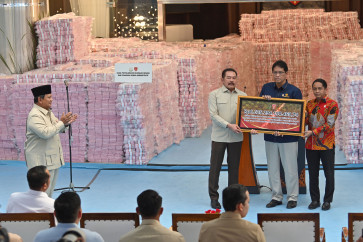Popular Reads
Top Results
Can't find what you're looking for?
View all search resultsPopular Reads
Top Results
Can't find what you're looking for?
View all search resultsFixing national food policy in the face of food crises
The majority of Indonesian farmers own small-unproductive plots that lack access to reliable irrigation and advisory services, trapping them in a situation of low productivity and income.
Change text size
Gift Premium Articles
to Anyone
“It is not easy to import rice now”, President Joko”Jokowi”Widodo told a regional heads gathering last week that discussed inflation and food prices in the country. Jokowi revealed that “just to import 500,000 tons of rice, we had to scramble around several exporting countries, but they preferred to hold their rice stocks, and did not want to sell “.
Jokowi’s remark underlines the global concern that due to supply disruptions and inflation triggered by the pandemic and the war in Ukraine, the world might be facing a food crisis. Indonesia will not be able to shield itself from this crisis. Although the government has made progress in increasing food production, especially rice, there is still a precarious demand and supply balance, because production and prices are vulnerable to several shocks. Stabilizing rice prices has been the major objective in the government food policy, since wide fluctuations in rice prices could have serious repercussions for the economy.
The rice price has a great influence on inflation because of its heavy weight in the Consumer Price Index. It also has influence in the standard calculation that determines the level of poverty. The rice price also has a great impact on the welfare of the poor, as they spend the bulk of their income on rice
Recently the rice price has been increasing putting more of a burden on the poor. According to Statistics Indonesia (BPS), the price of medium price in January was Rp 10,800 (US$0.72) per kilogram, an increase of 15 percent from January 2022, far exceeding inflation and wage growth.
Rice prices in Indonesia are higher than those in neighboring countries. According to the World Bank, Indonesia’s retail rice price has been consistently the highest in ASEAN over the last decade, with prices more than double the prices in Vietnam, Thailand, Cambodia and Myanmar.
The reasons for these high prices are not only structural but also the result of government policies. The structural reasons include the fact that the majority of Indonesian farmers own small, unproductive plots that lack access to reliable irrigation and advisory services, trapping them in a situation of low productivity and income. Their annual income is Rp 5.2 million, a level which is below the poverty line, reinforcing the fact that poverty in Indonesia is still a phenomenon of rural agriculture.
The complex geography and the long supply chain of the commodity across the country raise transportation and distribution costs and increase rice prices.



















